

Home
About Us
Allotments
Garden Equipment
Seed Suppliers
Manure Problems
Children's Pages
GLA Blog
Weather Blog
School Veg Patch
Useful Links
Choosing a Greenhouse
** This website is not a shop and doesn’t sell anything! **
Be aware that any external links may contain cookies and you should refer to the particular website's cookie policy
If you are going to raise your own plants from seeds then you are going to need some type of greenhouse in which to keep them protected until conditions are right for outdoor planting. Raising seeds inside the house is not usually successful as it is difficult to give young seedlings sufficient light, even on a window sill, in order to prevent them becoming weak and lanky
If blight is a problem where you garden it is also best to grow tomatoes under cover.
A greenhouse will also extend the length of time that you can carry out gardening activities and offer protection for the gardener, not only the plants, if weather is poor.
Choosing a Greenhouse
Before choosing a greenhouse you need to decide:
- What will you use it for?
- What size are the plants likely to be?
- Do you want to grow directly into the greenhouse border or in grow-bags or pots?
- When will you need staging?
- Is it just when growing seeds and growing on plants for planting outdoors in which case you may wish to have staging that is easily removed to make way for larger plants such as tomatoes in summer?
- Do you need space for a potting area or somewhere to store bags of compost etc?
Size
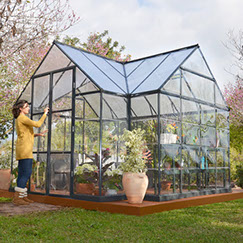 Most people wish that they had bought bigger greenhouses than they did and so choose as large a greenhouse as you can afford that will fit in the allocated space. Consider the width of the greenhouse, a wider greenhouse provides more growing space than a greenhouse with the same area but is longer and narrower. Less of the floor area will be devoted to pathways.
Most people wish that they had bought bigger greenhouses than they did and so choose as large a greenhouse as you can afford that will fit in the allocated space. Consider the width of the greenhouse, a wider greenhouse provides more growing space than a greenhouse with the same area but is longer and narrower. Less of the floor area will be devoted to pathways.
You will need to allow adequate space for pathways. Consider wheelchair or wheelbarrow access if this is likely to be required.
If you garden on an allotment there may be rules about the maximum size allowed.
Style
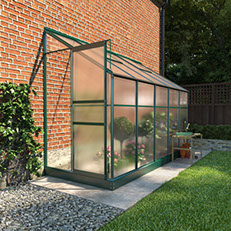 Lean to greenhouses are three sided structures which fit alongside an existing wall. To be effective growing spaces they would need to face south in order to access as much sunlight as possible. They only receive sunlight from one side. It is however, easier to provide an electricity supply to this type of greenhouse.
Lean to greenhouses are three sided structures which fit alongside an existing wall. To be effective growing spaces they would need to face south in order to access as much sunlight as possible. They only receive sunlight from one side. It is however, easier to provide an electricity supply to this type of greenhouse.
Traditional greenhouses are types that we are all familiar with; however there are different styles available.
Some greenhouse are built on a small wall these require more skill and planning in their construction. However, some wooden greenhouses mimic this style by having wooden panels at ground level. Although this may offer more safety and retain heat longer it does cut down on the amount of light reaching plants growing at ground level.
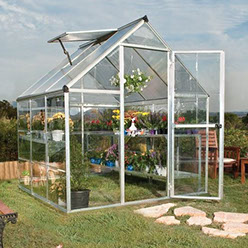
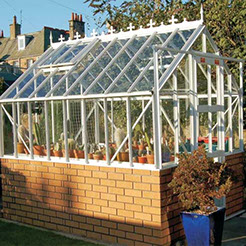
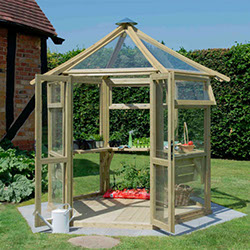
Hexagonal/Octagonal greenhouses are usually chosen where they are to become an ornamental garden feature.
Materials
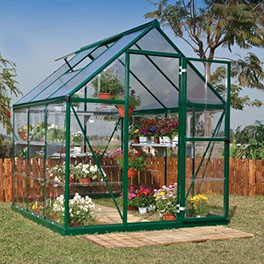
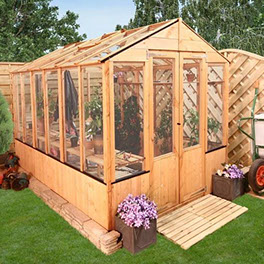 The choice of framework is basically wood or aluminium.
The choice of framework is basically wood or aluminium.
The temperature inside a wooden greenhouse is slower to fluctuate but an aluminium greenhouse is cheaper.
Wooden greenhouses need to be treated with wood preserver to prolong their life whereas aluminium greenhouses tend to be maintenance free.
Powder coated aluminium greenhouses are now available in green, brown and white as well as the more common silver.
Wood tends to be chosen where the appearance of the greenhouse is important.
Glazing
The obvious glazing material is glass but be aware that horticultural glass is less strong and when broken forms sharp glass shards which may be dangerous especially if children are likely to run about close to or inside the greenhouse. Although it is more expensive toughened or safety glass is much safer to use in a school environment.
Various types of plastic glazing materials such as polycarbonate, polythene and corrugated acrylic sheets are available and would be the safest options of all but all cut down on the amount of light entering the greenhouse. This type of glazing material is also very likely to blow out of the framework during windy weather leaving the greenhouse very vulnerable.
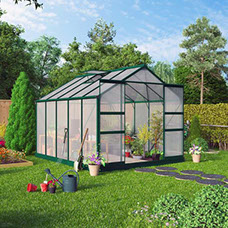
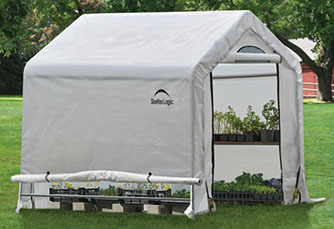
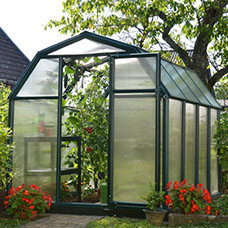
Polycarbonate glazing is often double skinned with a gap between the skins. This can be a problem in that insects can crawl inside or algae can grow between the skins reducing light even more. Both problems would be difficult to cure unless the ends of the sheeting are sealed in some way.
If the greenhouse must be situated close to a children’s play area some type of plastic glazing may be advisable to avoid damage from stray footballs etc.
Polytunnels
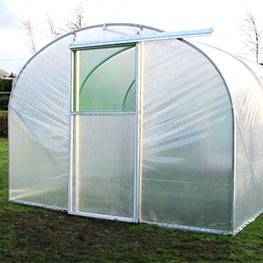 Polytunnels are are cheaper than an equivalent greenhouse but are not as durable. They would however provide a large growing and working space fairly cheaply if access was required for a class of children. Another advantage of a polytunnel is that they are in effect an indoor garden and in a large polytunnel plants can remain in the same place from seed to maturity.
Polytunnels are are cheaper than an equivalent greenhouse but are not as durable. They would however provide a large growing and working space fairly cheaply if access was required for a class of children. Another advantage of a polytunnel is that they are in effect an indoor garden and in a large polytunnel plants can remain in the same place from seed to maturity.
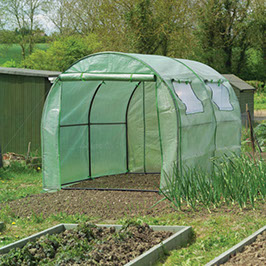 Polytunnels are available in various widths and lengths. The framework is usually galvanised steel which is covered with specially treated polythene to protect it from deterioration by the sun. The doors either have a wooden frame or are just openings where the polythene will roll-up to allow access. Vents are areas where the polythene can be rolled back. The covering will need to be replaced after about 4 years or sooner if damaged by the weather or sharp objects.
Polytunnels are available in various widths and lengths. The framework is usually galvanised steel which is covered with specially treated polythene to protect it from deterioration by the sun. The doors either have a wooden frame or are just openings where the polythene will roll-up to allow access. Vents are areas where the polythene can be rolled back. The covering will need to be replaced after about 4 years or sooner if damaged by the weather or sharp objects.
Mini-greenhouses
These are tall shelved structures covered with polythene. They open at the front to provide access. You can walk in to some. Being small, temperature and ventilation can be difficult to manage. They can however be useful for raising seedlings.
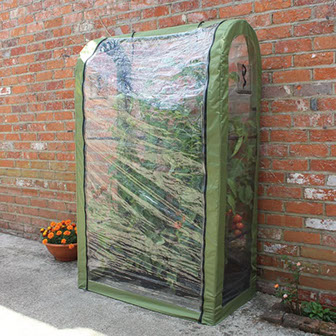
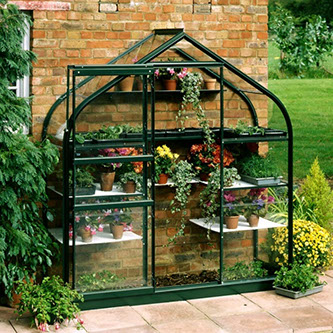
Cold Frames
Cold frames at their most basic are boxes with a lid. The lid is usually, but not always, sloping and so the cold frame is higher at the back than at the front. Like a greenhouse it can be made out of wood or plastic and glazed with glass or plastic. It shouldn’t be seen as a substitute for a greenhouse. Most gardeners will use a cold frame as a half way house between the pampered conditions inside a greenhouse and the rougher conditions outdoors. Many are home-made which could provide children with a design activity. More about cold frames here
Position
The best position for a greenhouse is in open ground where the greenhouse can enjoy as much natural sunlight as possible. If your site is very windy then you may have to compromise and place your greenhouse where it can be offered some protection from the strongest winds.
Remember areas that have plenty of light in summer may suffer from shade in winter when the sun is lower.
You should avoid siting your greenhouse on land that becomes waterlogged.
If you can, position your door so that it doesn’t face the most common direction of any prevailing wind.
Base
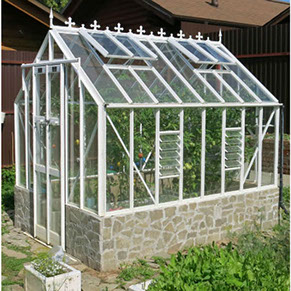 The ground on which the greenhouse is to be sited needs to be level and firm and the greenhouse needs to be very firmly anchored to prevent it disappearing in very windy weather. Many greenhouses are sold with a base provided.
The ground on which the greenhouse is to be sited needs to be level and firm and the greenhouse needs to be very firmly anchored to prevent it disappearing in very windy weather. Many greenhouses are sold with a base provided.
One point to consider is that greenhouses that are supplied with a base often have a step across the door entrance. This will make access with a wheelbarrow or wheelchair difficult so check with the supplier.
The greenhouse also needs to be well anchored .
Staging
This may be provided with your greenhouse or may need to be bought separately. Consider whether this is to be permanent or removable. Is it required down both sides of the greenhouse or just one side? If it is just erected on one side this needs to be on the shadier side of the greenhouse. Staging is available in wood or aluminium. You can also make your own purpose built staging. (More about staging here)
Ventilation
Greenhouses are ventilated by means of window openings in the roof or louvres and sliding windows opening in the side panels. The door opening is also a means of ventilation but it will often be preferable to keep this closed to avoid entry by cats or birds. A bird accidentally entering a greenhouse can make quite a mess when trying to find an escape route and cats love to snuggle up in the relative warmth having no consideration as to whether or not their beds is in an appropriate place.
An adequate level of ventilation is generally considered to be the ability to open up one 15-20% of the surface area of the greenhouse structure. It is likely that your greenhouse will not be supplied with as much ventilation as this and so you may wish to consider fitting extra roof openers or louvres. These can be bought with automatic opening devices which could prove very useful in an environment where you may not be on hand every day to open and close the ventilation.
Don’t just go for roof vents as this will not provide effective air circulation. Generally a proportion of one louvre to two roof vents should provide good air flow. You should also ensure that ventilation is spaced on both sides of the greenhouse.
Guttering
Not all greenhouses are provided with guttering which is essential in order to use a water butt in which to store and collect rainwater.
Heating/insulation
If you are to heat your greenhouse you will need to decide what type of fuel you are going to use, electricity, propane gas or paraffin. (More on heating here)
In a school environment unless you have a keen gardener on site it is likely that heating the greenhouse will be impractical. You may also feel that having flammable materials on a school site is not advisable depending on your situation.
If it is easy to provide an electricity supply to your greenhouse you may be able to use an electric heater with a thermostatic control.
You may wish to consider using an insulation material such as bubblewrap during the coldest period.
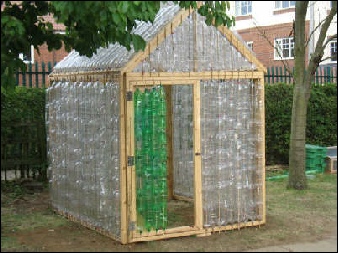
And for something completely different!
Try making your own green house from recycled plastic bottles.
Images taken from Garden Buildings Direct, Two Wests and Greenfingers
I’ve gathered together some links from companies offering gardening products for sale. I have no connection to the suppliers and therefore cannot be held responsible for any changes in items available or any issues that may arise when making a purchase.
Some companies give me a small commission on sales that are generated from this website which helps me to maintain this and sister websites but this in no way means that I am recommending purchases from a particular company.
Our Plot at Green Lane Allotments Blog | A Gardener's Weather Diary | School Vegetable Patch Website
© Our Plot on Green Lane Allotments - Please email me if you wish to use any of this site's content